Pro Drive
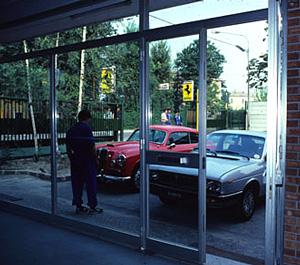
The Ferrari forecourt from reception.
The iron gate is in the distance. Could
that be the famous Crane Lancia B20,
right there in Maranello? A ride in a new
Testarossa awaits our Senior Editor.
The acrid smell of vaporized rubber wafted into the cockpit. Through its pale haze we watched the red Testarossa just ahead of us perform a slow pirouette. The driver had attempted a power-slide around an acute intersection and had been unable to catch it in time. In a moment of brilliance, he simply turned it into a great, smoking 180-degree spin and accelerated past us.
Enzo Compana, my driver for this adventure, and I glanced at each other, then burst into laughter as we made a less dramatic left turn. Enzo used 7000 revs the in first three gears as we blasted between a pair of ancient farm houses and continued our flight through the Italian countryside. Behind us was a train of three other Testarossas and a brace of 328s. Somewhere back up the mountain was a Mondial, a 412 in desperate pursuit and the errant Testarossa that had just entertained us.
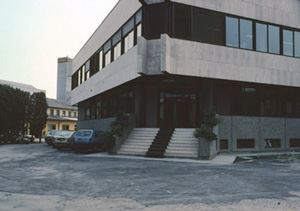
The Ferrari inner court, now filled with the
financial services building.
This remarkable fantasy had begun at 8:00 a.m. in the venerable, history-rich central courtyard of the Ferrari factory in Maranello, Italy. The courtyard was awash in activity. After wandering around the test cars for several minutes, I made my choice. The only yellow Testarossa I had ever seen. I reached up into the controversial side scoop and squeezed the door latch. It almost felt like I was doing something illicit. The latch was hidden up inside the upper skirt of the door. The door opened immediately and I settled into the broad leather seat.
A stocky, middle-aged chap in a red plaid shirt snapped open the driver’s door of the car I had claimed and quickly took his seat, made a couple of adjustments and twisted the ignition key; in one continuous motion. Suddenly, the Testarossa whirred and barked into life.
As Enzo Campana selected first gear. In seconds we were through the dark shadow of the famous tunnel through the ochre wall. We stopped briefly at the red-and-white striped gate at the front of the building. As soon as the uniformed guard recognized Enzo, he raised the barrier. After a quick wave we crossed the small forecourt, roared through the big steel gate and swept left onto Via Emilia.
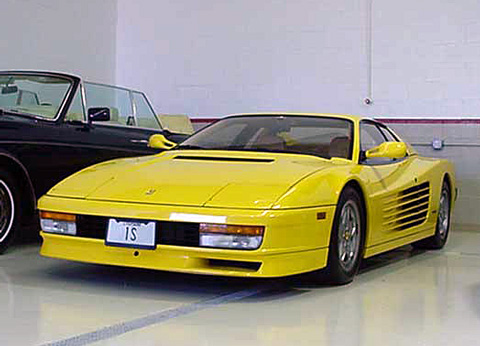
Crane picked a yellow Testarossa for his pro drive–a color rare in any country. This one, however, was spotted in the U.S.
Enzo Compana has spent 24 years of his life driving Ferraris con brio in the mountains around Maranello. He is the definitive test driver, possessing the light, deliberate touch of a surgeon; precision above all. As we made our departure, he pressed lightly on the brakes while we were still in second gear; on to third and fourth, then more firmly on the brakes. He tried the lights, the windshield washer. The engine warmed quickly, the gearbox slowly. First, he used no more than 4000 revs. We swept up a set of bends into the mountains at 5000 revs in third, high on the engines torque curve. By then we were going very quickly. Before each blind turn Enzo would give two blasts from the air horns. The engine screamed. It was fully up to temperature, 200 degrees Fahrenheit. The gearbox was hot and quick. Seventy…eighty mph. Close by a barn. Two short blasts of the horns. We fairly flew by stone walls with inches to spare. The towering junipers connected in a gray-green blur. A hard left between an ancient farm house and its graceful stone barn was accomplished in a 60-mph drift. The horns, the brakes and the gearbox all got equal attention. The odor of burning paint mixed with cooking brake pads. I kept my window partly open in deference to my unsettled stomach. We had gone no more than ten miles when we swept right into a fantastic view high above the valley of the Panaro.
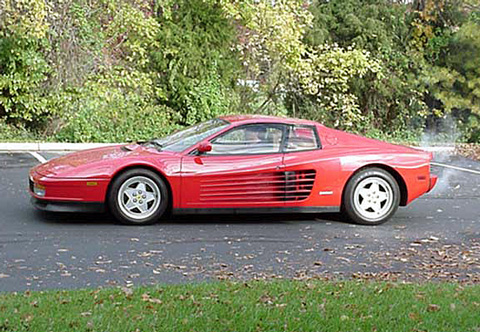
Ferrari test drives in the U.S. just don’t seem to have the same aura as those performed in Italy.
We came to a smoking stop, seatbelts tightening. All four fenders released tiny, whispy clouds of smoke from their brakes. The big flat-12 stopped instantly when the ignition was switched off. Enzo reached behind my seat and withdrew a clipboard full of forms. Silently he flipped through them, showing me each one in turn. It was time to check the car.
Every hatch was opened before Enzo stepped out into the sunshine. Hood, doors and decklid stood agape before the next Ferrari screamed into view and pulled off the road. One by one the cars parked across from us. Within minutes all were present and all hatches were open.
Enzo discovered a loose light fixture on the hood. He constantly checked and rechecked. Brief notes were jotted on the forms about irregularities imperceptible to me. The hood was slammed shut. Then engine cover thumped and clicked closed. Suddenly, Enzo stood by the driver’s door and smiled. Just as suddenly, he was seated, his door closed and he engine running. I fumbled with the seatbelt as he engaged first gear. As my seatbelt buckle snapped, we launched.
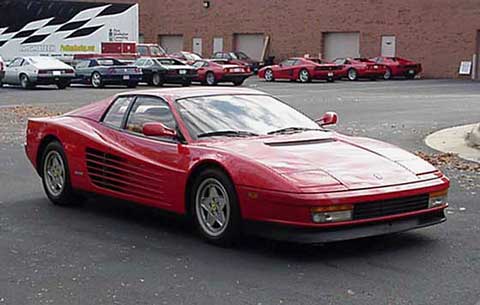
The Testarossa departed in many ways from Ferrari tradition, including the use of the controversial “strakes” as intake devices.
After a quick descent we approached an autostrada entrance. With a wave to the local motorcycle cop, we were on, accelerating hard. We did several miles in traffic at 140 mph.
After about a quarter of an hour, we were back on the mountain tour. We never saw much more than 100 mph in the mountains. But keep in mind we were on narrow country lanes—where one is constantly reminded that this is a very wide car. The Testarossa’s size and 380 bhp can be formidable, yet after watching Enzo Compana extend it to its limits, I never felt the car was beyond his control. He used the brakes very hard, the clutch, gearbox and tires no less so. I got a good impression of Ferrari’s ultimate capability on a public road. With a liberal use of the air horns and an exhaust note that reached far into the canyons above us, our approach was clearly announced. Enzo managed to use every g-load available. My relatively light breakfast made itself known…
My right hand lightly gripped the grab handle designed into the passenger door. That same church wall now passed within inches of my hand as we braked from 75 mph into a tight right turn. It made me consider how far beyond my hand were the rear fenders. But the big Michelins had already relinquished their grip several yards before the wall swept past my door. The old blacktop was smooth, almost slick, and the Michelins had all they could do to control the ton and a half of kinetic energy.
Watching a professional Italian test driver use a Ferrari is an education in style. He kept his hands near the bottom of the wheel; at about 8 and 4 o’clock positions. Enzo’s index fingers pointed up either side of the wheel most of the time. In tight turns he fed the wheel through his hands with blinding quickness, then let the wheel rush back through his fingers as it recentered itself. No straight-arm stretch for the modern professional; just a relaxed grip, punctuated by frenetic activity.
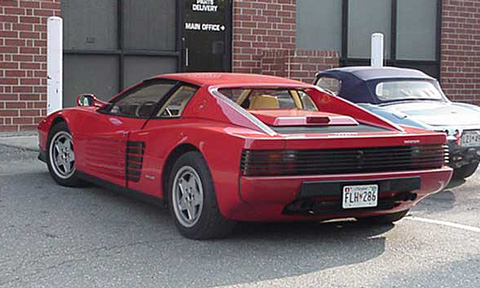
Introduced in 1984, the Testarossa was wide, powerful, demanding, and spectacular. This is a U.S. version.
Shortly before noon we stopped at Ristorante Colombaccio high in the mountains near Sassuolo. The balance of our glistening train took up positions along the spectacular overlook. For the Americans, in anticipation of the descent, lunch was taken with some restraint.
I elect to ride in a 328 for the return to the factory. A confident young driver got in. I got nervous. He was too young. Within minutes I scribbled in my notebook, “Now very fast. His gearchanges become art. The car screams; drifts; the tires howl with fury. Mille Miglia. Targa Florio. Prova (testing). Who is this guy?” He is Felice Sabatelli. We chased the yellow Testarossa. Felice had to work to keep up. We both enjoyed the effort and the view.
Watching the broad tail of the Testarossa sliding, drifting, sometimes shrouded in tire smoke, we proceeded apace. Even with the roar of the V-8 in my ears, I could still distinguish the wail of the big 12 up ahead.
We had covered about 45 miles when we burbled quietly to the factory’s side gate. We idled so gently up the incline into the courtyard that I had the impression we were all adolescents sneaking home from a forbidden adventure.
Crane’s writing and powers of observation are wonderous – my heart and soul were with him visualizing AND tasting every moment and morsel of his journey into the Ferrari foothills.
Years ago when writing narration for documentary films at David Wolper Productions, the producer of the series I was working on said that my words would have to have juice. I asked what he meant by juice. He said juice is what makes it real. It’s what takes the audience right into it and keeps it there until the writer is done with what is being written.
Larry Crane’s words have juice.